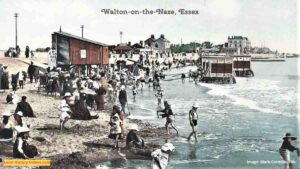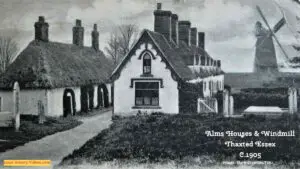Glimpse history through old images West Hangingfield, Essex, England.
Hangingfield Reservoir 1954
Hangingfield Reservoir was created by flooding the 1,000 acre Sandon Valley.
A small hamlet of farms, houses, and cottages was abandoned and flattened, before the land was submerged under water.
Fremnells Manor, a large 16th century manor house with 19 bedrooms, was also demolished. Stones were removed from the site to make new dams on the River Chelmer and River Blackwater, thus diverting the river water into the new reservoir.
Large trees, too, were taken down and removed.
Alex Frood’s family are shown leaving their 100 acrea farm and its lovely traditional farmhouse. Mr Frood inspects the last crop to be harvested before the flood waters arrive.
The final scene shows the empty Fremnells Manor, whose demolition had even been questioned in the House of Commons in 1951.
Essex Reservoir (1954) – British Pathé on YouTube
A Bit of West Hangingfield History
Extract from:
The history and topography of … Essex – Volume 1
by Thomas Wright
Published in 1836
Pages 136 – 138
WEST HANNINGFIELD. This village and parish are situated twenty-nine miles from London. The population consists of two hundred and forty-eight males and two hundred and twenty females, totaling four hundred and sixty-eight.
At the time of the general survey, it was held by William Warren, Earl of Surrey. The parish encompasses the paramount lordship and four other manors.
Cloville’s Hall takes its name from the Cloville or Clonville family, who owned the estate from the reign of Henry II until 1664. Subsequently, the property passed to Mrs. Richard Finch.
Hanningfield Temple derives its name from its historical connection to the Knights Templars. The part known as Parages or Pagetts likely relates to an individual with that name.
In 1541, Henry VIII granted it to John Cannon, a merchant-tailor of London. John’s son, Richard, inherited the estate. Richard, who remained unmarried, passed away in 1727. He bequeathed the Parages estate to Humphry Sidney, Esq. of Margaretting. The Temple manor portion came into the possession of Mr. Drage, who later sold it to Daniel Williams, V.D.M., and D.D. In a codicil to his 1712 will, Mr. Williams bestowed it upon his wife for her lifetime, after which it was to benefit the cities of Glasgow and Edinburgh for the establishment and endowment of alms-houses. Daniel Williams’ other extensive charitable acts are documented under Tolleshunt Major.
Peverels is a manor that has been held by a branch of the Peverel family since 1311. In 1611, a survey indicated that this manor encompassed three hundred and eight acres, two rods, and two perches of land. It passed from the Peverels to William Cloville in 1469, and his brother Edward became the heir. The Tanfield family subsequently owned it, and around 1678, it was sold by Daniel Tanfield to the aforementioned Dr. Williams. The manor house is located one mile from the church.
Chervilles is the last of the subordinate manors and has records of Michael de Cherville holding it in 1254. A trial occurred in Chelmsford in that year between Michael de Cherville and Ernald de Berkheld, among others, regarding their common pasture rights in West Hanningfield. In 1489, it was held by John Wawton, on behalf of Sir George Neville, Lord Bergavenny. His daughter and heir, Cicely, was three years old at his death that year. Through marriage or other means, it later came into the possession of John Cannon, and it was then referred to as the hamlet of Chervilles. The property later belonged to the Humfries. The manor house is not far from the church. There is also a good house near the church, known as the church-house, which was formerly owned by the same family.
The manor in this district known as Bedenested, which gave its name to Petronilla de Bedenested and Albric de Bensted, appears to have been a place of importance, as indicated in Domesday Book. The name Bensted-green still remains, but little more is known about it.
The church features a nave and chancel, each with a south aisle. It is dedicated to St. Mary and St. Edward. An octagonal tower at the west end houses four bells, with a wooden spire above.
Within the south aisle is a stone of very antique appearance, bearing the brass inlaid half-length effigies of a man and a woman. The male effigy is missing, but the female figure remains. Below it is the following Old English inscription:
“Isabele Clovill and John her son lie here; the last-mentioned John died on the 23rd day of October, in the year of grace 1361. May God have mercy on their souls.”
An altar tomb is situated on the north side of the chancel, made of gray marble and belonging to the Clovill family. However, the inscription is illegible. On the floor nearby, there is a white stone with the effigy of a youth, and the border inscription reads:
“Here lies John Erdeswicke, son and heir of Richard Erdeswicke, Esquire, who died in November, 160…”
The rest of the inscription is defaced.
The parsonage house is a well-maintained building with a brick front, significantly improved by the Reverend Henry Burton during his time as rector.
The rectory of West Hanningfield is valued at £162 13s 4d in the king’s books. Richard Cannon, who passed away in 1605, bequeathed five pounds per annum for eternity to be distributed in bread to the poor of this parish. Mrs. Ann Humfry donated forty shillings annually to impoverished widows who did not collect, with the funds to be paid out of Chervilles.
More about Essex
- Old Images of Essex, England
- Old Images of West Hangingfield, Essex
- Old Images of Purfleet (Purfleet-on-Thames), Essex
- Old Images of Wickford, Essex
- Old Images of West Thurrock, Essex
- Old Images of Walton-on-the-Naze, Essex
- Old Images of Tilbury, Essex
- Old Images of Thaxted, Essex
- Old Images of South Ockenden, Essex









